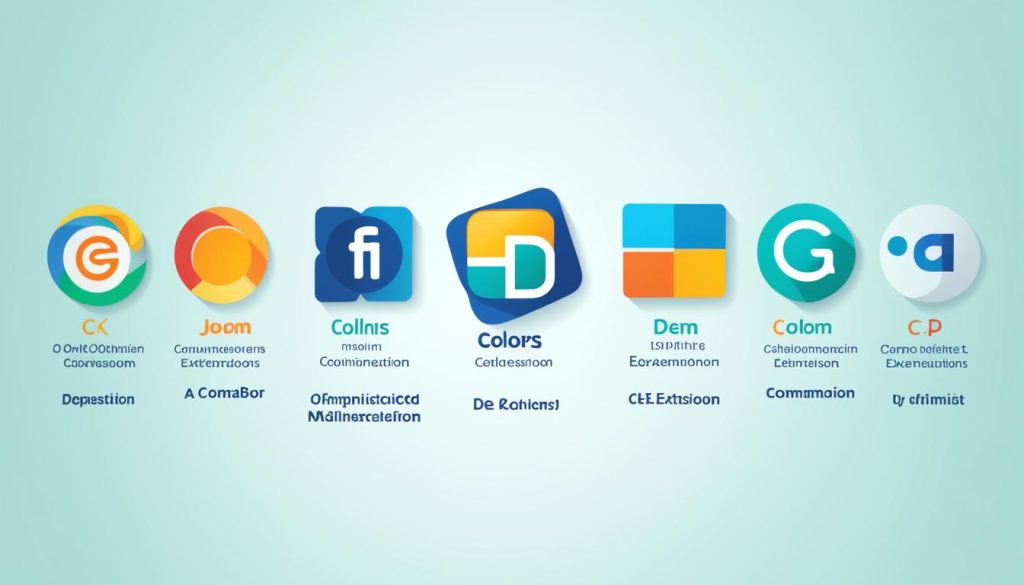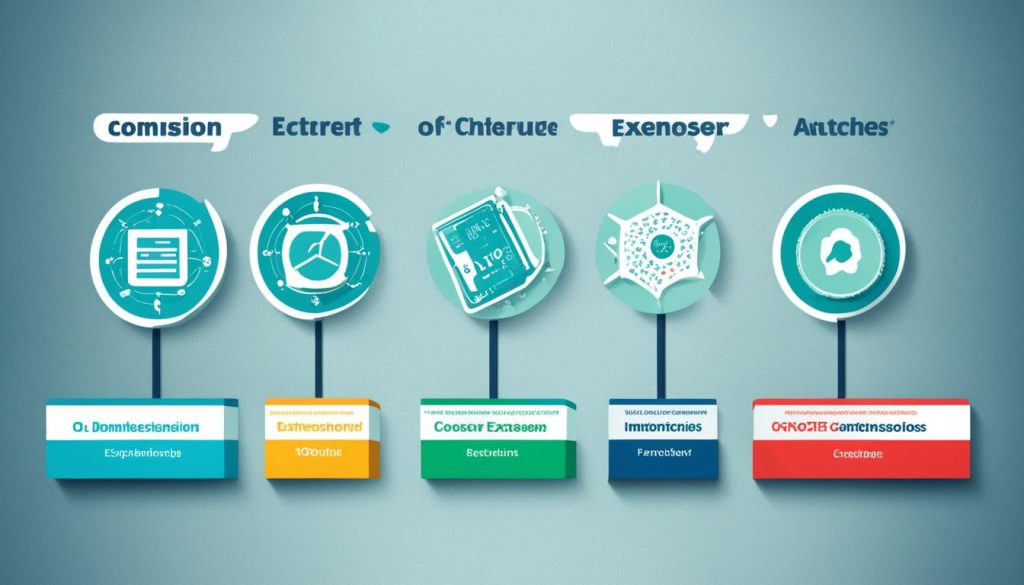Examples of Domain Name Types and Extensions (2024)
Did you know that there are approximately 2,000 domain extensions available today? These extensions, also known as top-level domains (TLDs), are suffixes that come after the last dot in a website’s domain name. They play a crucial role in classifying websites based on their organization type, location, and purpose.
Understanding the different types and meanings of domain extensions can help you make informed decisions when choosing the right one for your website. Let’s explore some examples of domain name types and extensions to gain a deeper understanding of this important aspect of your online presence.
Key Takeaways:
- There are approximately 2,000 domain extensions available today.
- Domain extensions, or top-level domains (TLDs), classify websites based on organization type, location, and purpose.
- Understanding domain name types and extensions can help you choose the best one for your website.
- Examples of domain extensions include .com, .org, and .net.
- Choosing the right domain extension is crucial for branding and attracting the right audience.
History of Domain Extensions
The history of domain extensions can be traced back to the 1980s when the Internet Assigned Numbers Authority (IANA) introduced six extensions to represent different types of organizations.
These extensions, known as top-level domains (TLDs), became a way to classify websites based on their organizational type and purpose. For instance, .com was designated for commercial entities, .org for non-profit organizations, and .gov for government agencies.
In the 1990s, country code TLDs (ccTLDs) were introduced, allowing websites to represent specific countries and territories. ccTLDs became a way to identify the geographical location associated with a website. Some examples of ccTLDs include .ca for Canada, .uk for the United Kingdom, and .de for Germany.
As the internet continued to evolve, additional domain extensions were introduced to cater to specific industries and interests. These included domain extensions such as .edu for educational institutions, .mil for military organizations, and .info for informational websites.
Currently, domain extensions can be classified into three primary types:
- Country-code top-level domains (ccTLDs): These extensions are specifically designed to represent different countries and territories. They play a crucial role in identifying the geographical location associated with a website. Examples include .us for the United States, .jp for Japan, and .au for Australia.
- Sponsored top-level domains (sTLDs): These extensions are associated with specific communities or groups and are generally restricted to certain niches or industries. They are maintained by organizations or entities that oversee their use. Examples include .gov for U.S. government agencies, .edu for accredited educational institutions, and .travel for the travel industry.
- Generic top-level domains (gTLDs): These extensions are versatile and are not limited by regional affiliations or country codes. They are widely recognized and commonly used for various purposes. Examples include .com, .org, .net, and .info.
The evolution of domain extensions has allowed for greater specificity and customization in website addresses. Businesses, organizations, and individuals now have a wide range of options to choose from when selecting a domain extension that aligns with their brand identity and target audience.
Types of Domain Extensions
When it comes to domain extensions, there are several types to choose from, depending on your specific needs. Let’s take a closer look at the three main categories of domain extensions:
Country-Code Top-Level Domains (ccTLDs)
Country-code top-level domains are designed to represent specific countries, sovereign states, and territories. These domain extensions are an excellent choice if you want to target a specific geographic region or cater to a local audience. For example, the domain extension .za is associated with South Africa, while .us represents the United States. By using a ccTLD, you can establish a stronger online presence within a specific country or region.
Sponsored Top-Level Domains (sTLDs)
Sponsored top-level domains are closely tied to specific communities, groups, or industries. These extensions are restricted and require eligibility criteria to register a domain. sTLDs are a great option if you want to showcase your affiliation with a particular niche or demonstrate your expertise within a specific field. For instance, .gov is reserved for U.S. government agencies, while .edu is exclusively used by accredited educational institutions.
Generic Top-Level Domains (gTLDs)
Generic top-level domains are versatile and not limited by regional affiliations or country codes. They are widely recognized and accepted across the globe. These extensions can be used for various types of websites and organizations. The most common gTLDs include .com, .net, and .org. Choosing a gTLD can provide flexibility and a broader reach for your website or business.
When selecting a domain extension, consider your target audience, the purpose of your website, and your brand identity. Each type of domain extension has its benefits and can contribute to your overall online presence. Choose the one that aligns with your goals and helps establish a strong brand identity.

Three Most Common Domain Extensions
When it comes to choosing the perfect domain extension for your website, it’s important to consider the most common options that are widely accepted and recognized. Out of the thousands of domain extensions available, the top three most popular ones are .com, .org, and .net.
The .com domain extension is the most widely recognized and commonly used, with a market share of approximately 52.8%. It is a versatile choice suitable for a wide range of websites and organizations.
The .org domain extension, originally intended for non-profit organizations, is the second most popular option, with a market share of 4.4%. It is an excellent choice if you’re running a non-profit or charitable organization.
The .net domain extension, which originated as a domain extension for network services, is the fourth most popular option, with a market share of 3.1%. It is a great choice for websites related to networking, technology, or internet services.
These three domain extensions – .com, .org, and .net – are widely accepted and can play a crucial role in enhancing the online presence and branding of your website. Choosing any of these popular domain extensions can help establish credibility and trustworthiness with your audience.
| Domain Extension | Market Share |
|---|---|
| .com | 52.8% |
| .org | 4.4% |
| .net | 3.1% |
Importance of Choosing the Right Domain Extension
Choosing the right domain extension is crucial for the branding and success of your website. The domain extension you select plays a significant role in shaping your brand identity and reaching your target audience effectively.
When you choose a domain extension that aligns with your brand identity, it enhances brand recognition and credibility. It helps establish trust with your audience, making them more likely to engage with your website and offerings. For example, a .com extension is widely recognized and used by businesses, while a .org extension is commonly associated with non-profit organizations.
Moreover, the domain extension you choose should resonate with your target audience. It should reflect the nature of your business or website, helping you attract the right visitors. For instance, if you’re targeting a local audience in Canada, using a .ca domain extension can signal your relevance and make your website more appealing to Canadian users.

By selecting the right domain extension, you can also improve your online visibility. When users search for relevant keywords in search engines, having a domain extension that aligns with their search terms can increase the chances of your website appearing in the search results. This can lead to more organic traffic and better exposure for your brand.
In conclusion, the domain extension you choose can have a significant impact on your website’s branding, target audience, and overall success. Therefore, it’s essential to carefully consider the options and select a domain extension that best represents your brand identity, resonates with your target audience, and enhances your online visibility.
Tips for Choosing the Best Domain Extension
When choosing the best domain extension for your website, there are several important factors to consider. Firstly, think about the purpose of your website and what you want to achieve. Are you running a business, a blog, or an online store? Understanding the purpose will help you choose a domain extension that aligns with your goals.
Next, consider your target audience. Who are you trying to reach with your website? Different domain extensions have different meanings and associations, so you want to choose one that resonates with your target audience. For example, if you’re targeting a specific country, using a country-code top-level domain (ccTLD) like .ca for Canada can help establish a local presence.
Another valuable tip is to conduct research and use a domain name generator for inspiration. This can help you come up with unique domain name ideas that haven’t been taken yet. Additionally, creating a domain name checklist can be useful to ensure you cover all the important aspects, such as brand consistency, memorability, and SEO friendliness.
Lastly, don’t limit yourself to the most common domain extensions like .com, .org, and .net. While these are popular choices, there are countless alternatives available that may better suit your business name and branding goals. Consider extensions that are relevant to your industry or niche, such as .tech for technology-focused websites or .design for creative businesses. Exploring these options can help you find a domain extension that truly stands out.
FAQ
What are domain extensions?
How many domain extensions are there?
What is the history of domain extensions?
What are the types of domain extensions?
Which are the three most common domain extensions?
Why is choosing the right domain extension important?
What are some tips for choosing the best domain extension?
- How Strategic SEO Drove Growth for a CPAP E-commerce Brand - July 24, 2025
- Top 3 SEO Companies in Toronto: An Analytical Comparison - July 23, 2025
- SEO for Entry Door Services - April 24, 2025





















Post Comment
You must be logged in to post a comment.